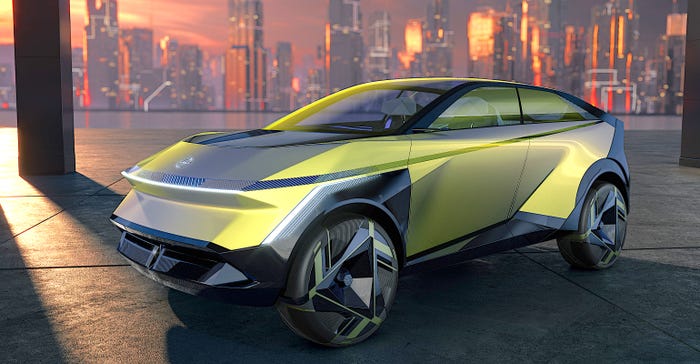Nissan Showcases Virtual Concept Cars
Are they real even if they don’t exist in the physical world?

Nissan is exploring some possible EV designs by teasing us with some “digital concepts” of electric vehicles that could employ some interesting features. “Digital concept” means that, unlike regular concept cars, these nifty Nissan’s exist only as zeros and ones on the company’s computers.
But because you’re reading about them in that same format, maybe it doesn’t really matter whether there was a physical example that served as the model for a photograph, as long as the engineering has been worked out.
Celebrating the History of Nissan's Satellite Design Studios
The concepts are the Nissan Hyper Adventure and Hyper Urban. They are both EVs that feature V2X charging technology that lets them share their stored energy.
The Hyper Adventure employs Nissan’s advanced e-4ORCE all-wheel-control system for the ability to reach adventurous, off-the-path destinations.
Both the Adventure and the Urban concepts are more notable for being able to put the power down to other electric devices rather than to the road, however.

Their batteries double as an energy source, allowing users to power up their gadgets, light up campsites, or even recharge their electric jet skis. Less recreationally, their V2X capability can also provide power to homes (V2H) or a local community by contributing surplus power to the grid (V2G).
Seeking to be a good neighbor, the Hyper Urban incorporates an Intelligent Charging Management System whose AI can autonomously charge other vehicles and power buildings, providing efficient management of power.

Additionally, the Urban acknowledges that the best way for a vehicle to reduce its environmental impact is to last a long time, so it doesn’t need to be replaced. To this end, Nissan has made the Hyper Urban hardware upgradable, with an instrument panel that can be replaced later with one that reflects the latest technologies. Obviously, like all new cars, the software in both vehicles can be updated over the air to keep them on the leading edge of software-defined features and capabilities.
Obviously, both vehicles are intended to showcase the work of Nissan’s designers.
The Hyper Adventure’s bodywork directs the air flowing through the front spoiler for increased aerodynamic downforce, while flush-mounded glass that integrates the roof and side windows and the surface of the rear end minimizes drag.
In a nod to snow sports and the traction needed to get to the slopes, the wheels and front and rear bumpers are outfitted with crampons, or snow traction gears, to allow the car to drive through snowy areas with ease.

There’s cargo space inside the Adventure for outdoor equipment such as tents, skis, or even a kayak. The car’s most unusual interior feature is the rear bench seat that can flip 180 degrees on an axle to provide a comfortable rear seating area that faces out of the vehicle’s hatch. It even includes automatic extendable and retractable steps at the rear of the car.
The Hyper Urban seeks to provide a sense of openness and character through its use of wide-opening scissor doors front and back. The Urban’s seat trick is its front seats that can collapse and fold into the back seats to create a sofa-like, private relaxing space for the crowded urban environment.
About the Author(s)
You May Also Like





